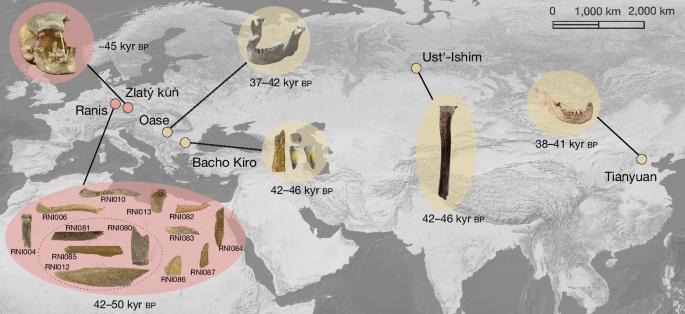最早的现代人类基因组限制了尼安德特人混合的时间
IF 48.5
1区 综合性期刊
Q1 MULTIDISCIPLINARY SCIENCES
引用次数: 0
摘要
现代人在45000多年前到达欧洲,与尼安德特人1 - 4至少重叠了5000年。来自这些早期现代人的有限基因组数据表明,至少有两个基因截然不同的群体居住在欧洲,以捷克人Zlatý kůň和保加利亚人Bacho Kiro为代表。在这里,我们通过分析来自德国拉尼斯Ilsenhöhle约45,000年前的遗骸的一个高覆盖基因组和五个低覆盖基因组,以及来自Zlatý kůň的另一个高覆盖基因组,加深了我们对早期现代人类的理解。我们表明,遥远的家族关系将拉尼斯人和Zlatý kůň个体联系在一起,他们是同一个小的、孤立的群体的一部分,代表了已知的与非洲外谱系最深刻的分裂。拉尼斯人的基因组中含有尼安德特人的片段,这些片段起源于一次与所有非非洲人共有的单一混合事件,我们将其追溯到约4.5万至4.9万年前。这意味着,迄今为止测序的所有非非洲人的祖先在这一时期都生活在一个共同的人群中,并进一步表明,来自非洲以外5万年以上的现代人类遗骸代表了不同的非非洲人群。本文章由计算机程序翻译,如有差异,请以英文原文为准。

Earliest modern human genomes constrain timing of Neanderthal admixture
Modern humans arrived in Europe more than 45,000 years ago, overlapping at least 5,000 years with Neanderthals1–4. Limited genomic data from these early modern humans have shown that at least two genetically distinct groups inhabited Europe, represented by Zlatý kůň, Czechia3 and Bacho Kiro, Bulgaria2. Here we deepen our understanding of early modern humans by analysing one high-coverage genome and five low-coverage genomes from approximately 45,000-year-old remains from Ilsenhöhle in Ranis, Germany4, and a further high-coverage genome from Zlatý kůň. We show that distant familial relationships link the Ranis and Zlatý kůň individuals and that they were part of the same small, isolated population that represents the deepest known split from the Out-of-Africa lineage. Ranis genomes harbour Neanderthal segments that originate from a single admixture event shared with all non-Africans that we date to approximately 45,000–49,000 years ago. This implies that ancestors of all non-Africans sequenced so far resided in a common population at this time, and further suggests that modern human remains older than 50,000 years from outside Africa represent different non-African populations. High-coverage and low-coverage genomic data for some of the earliest modern humans in Europe provide insights into recent admixture with Neanderthals and familial relationship links with distant communities approximately 45,000 years ago.
求助全文
通过发布文献求助,成功后即可免费获取论文全文。
去求助
来源期刊

Nature
综合性期刊-综合性期刊
CiteScore
90.00
自引率
1.20%
发文量
3652
审稿时长
3 months
期刊介绍:
Nature is a prestigious international journal that publishes peer-reviewed research in various scientific and technological fields. The selection of articles is based on criteria such as originality, importance, interdisciplinary relevance, timeliness, accessibility, elegance, and surprising conclusions. In addition to showcasing significant scientific advances, Nature delivers rapid, authoritative, insightful news, and interpretation of current and upcoming trends impacting science, scientists, and the broader public. The journal serves a dual purpose: firstly, to promptly share noteworthy scientific advances and foster discussions among scientists, and secondly, to ensure the swift dissemination of scientific results globally, emphasizing their significance for knowledge, culture, and daily life.
 求助内容:
求助内容: 应助结果提醒方式:
应助结果提醒方式:


